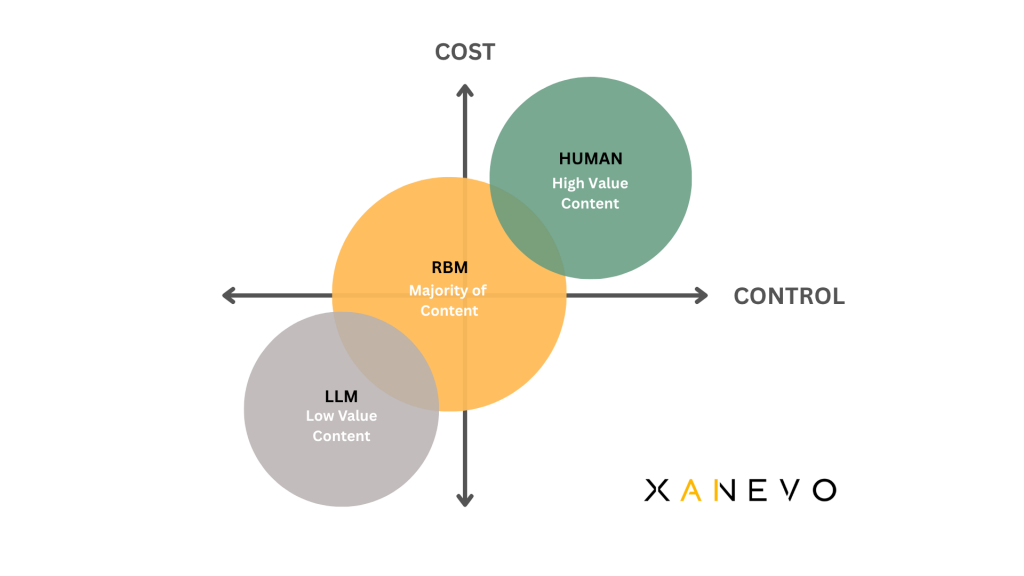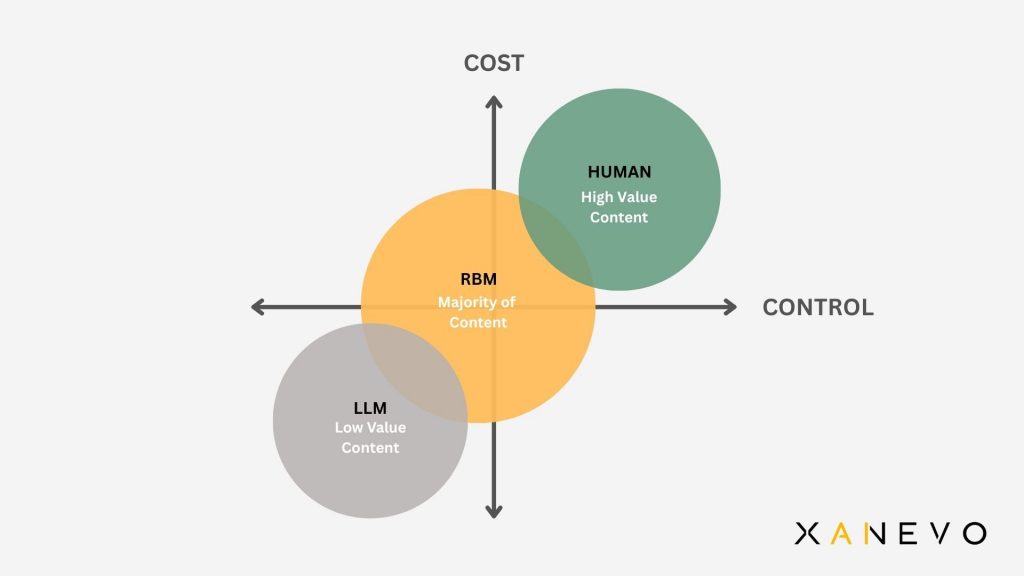Scaling AI Content Without Sacrificing Quality: Best Practices, Technologies, and Use Cases for 2025
By Jan Kaiser, Managing Director & Founder @ Xanevo, AI Consulting Services for e-Commerce

AI-powered copywriting leverages artificial intelligence to efficiently generate high-quality content at scale for businesses of all sizes.
This comprehensive guide explores cutting-edge AI copywriting technologies, compares different approaches, and demonstrates how to reduce content production time by up to 80% through strategic implementation. Success lies in finding the right balance between AI efficiency and human oversight.
What is AI Copywriting and Why It’s Essential in 2025
AI copywriting is the technology-assisted generation of text content, either partially or completely automated. It relies on two primary technologies:
- Rule-based models (RBMs)
- Generative AI powered by large language models (LLMs)
Since 2023, the technology has rapidly evolved from simple text completion tools to sophisticated content ecosystems that support the entire workflow—from ideation to performance tracking and optimization.
How AI-Powered Content Creation Actually Works
There are two distinct technological approaches to automated content creation, each with unique strengths and limitations. Selecting the right approach for your specific use cases is crucial for success.
1. Rule-Based Models (RBMs)
What are RBMs? Technology that transforms structured data into natural language text following a systematic process:
- Data input: Feeding structured data (spreadsheets, databases) into the system
- Content planning: Defining structure and information hierarchy
- Text generation: Creating grammatically correct content modules using linguistic rules
- Brand alignment: Adapting tone, style, and brand voice
RBMs excel at:
- Converting large volumes of structured product data into quality product descriptions
- Data-driven reports (financial summaries, analytics reports, weather updates)
- Content with strict compliance requirements and specifications
Example: An e-commerce retailer with 50,000 products uses RBMs to automatically generate consistent product descriptions from their product database (specifications, dimensions, materials, etc.).
Recommended tools: RosaeNLG (Open Source), Textengine, Axite
2. Generative AI (Large Language Models)
Modern generative AI models like OpenAI GPT-4 and Claude 4 use neural networks and follow a different approach:
- Prompt engineering: Users provide detailed instructions (“prompts”)
- Context analysis: AI analyzes the task and identifies patterns
- Content generation: Creates content based on training data
- Iterative refinement: Results are optimized through feedback loops
Generative AI excels at:
- Creative content and initial drafts
- Flexible, smaller-scale content without complex specifications
- Brainstorming and overcoming writer’s block
Example: An e-commerce company uses LLMs to quickly create seasonal product descriptions and ad copy. Human editors review all content for quality and accuracy before publication.
Recommended tools: Claude 4, OpenAI GPT-4
Note: Hybrid solutions combining both LLM and RBM technologies (like Textengine) can offer compelling alternatives.
Technology Comparison Matrix
| Human Writing | Rule Based Models (RBM) | Hybrid Models | Large Language Models (LLM) | |
| Reliability (based on 5.000 texts) | 99% (no proofreading required) | 99% (no proofreading required) | 80 % (human proofreading recommended) | 30 – 70 % (human proofreading recommended) |
| Scalability (multichannel text variants and languages) | 0% | 70 – 85 % | 70 – 85 % | < 10 % |
| Cost per text (excl. license costs) | > 6 – 15 € | 2 – 5 € | 1 – 3 € | 0,20 – 1 € |
*Based on 5,000 text samples **Multichannel variants and languages ***Excluding license costs
Some Use Cases
- E-commerce: Product descriptions, meta descriptions, alt tags
- Marketing: Social media content, Newsletters, Advertisement
- Corporate communications: Reports, press releases
- SEO: Optimized landing pages & Blog Content
4-Step Implementation Roadmap
Step 1: Assessment and Goal Setting
- Audit current content processes and identify bottlenecks
- Define content requirements and quality standards
- Establish specific ROI goals and budget parameters
Pro tip: Set clear, measurable ROI expectations from the start.
Step 2: Tool Selection and Pilot Program
- Evaluate content quality requirements against costs using our Cost-Control Matrix
- Select appropriate tools for your use cases
- Define pilot scope and success metrics
Pro tip: Start with less creative but higher-value content formats.

Cost-Control-Matrix – Our proprietary framework helps you select the right approach based on your specific needs | XANEVO
Step 3: Process Integration and Team Training
- Develop scalable, repeatable workflows
- Set up automation (define rules or prompt chains)
- Document best practices and create style guides
- Implement quality assurance protocols
- Plan ongoing team training
Pro tip: Define roles and responsibilities clearly from day one.
Step 4: Measurement and Continuous Optimization
- Track production time, quality metrics, and costs
- Collect team and stakeholder feedback
- Continuously refine your strategy
Success story: Fashionista.de increased productivity by 62% and conversion rates by 17% through strategic AI integration.
Limitations and Ethical Considerations
Despite significant advances, challenges remain with automated content creation:
- Factual accuracy with LLMs: Risk of generated misinformation persists
- Creative limitations: Human insight remains essential for strategic content
- Transparency requirements: Readers should understand when content is AI-generated
Key Takeaways: AI Content as a Strategic Advantage
By 2025, AI-powered content creation is no longer emerging technology—it’s a proven method for dramatically improving content efficiency. Companies that implement structured processes, appropriate tools, and clear quality standards can reduce production time by up to 60% while delivering consistent, brand-compliant content at scale.
The combination of rule-based systems and generative AI enables precise tool selection based on specific use cases—from product descriptions and newsletters to SEO content. Strategic planning around different technological approaches is absolutely critical.
This is why we developed our cost-control matrix at XANEVO. Use it to categorize your content requirements and identify the optimal approach for each use case.
The Success Formula:
- AI for efficiency: Routine tasks, first drafts, scaling operations
- Humans for quality: Emotional resonance, fact-checking, strategic oversight
About the Author
Jan Kaiser is a Chief AI strategist specializing in AI-powered content optimization. With over 15 years of experience in digital transformation, he advises companies on strategic AI implementation in content marketing.
